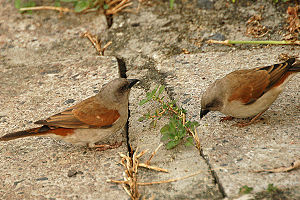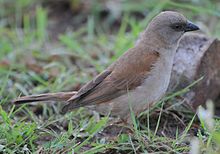Gray-headed Sparrow
| Gray-headed Sparrow | ||||||||||||
|---|---|---|---|---|---|---|---|---|---|---|---|---|

Gray-headed Sparrow ( Passer griseus ) |
||||||||||||
| Systematics | ||||||||||||
|
||||||||||||
| Scientific name | ||||||||||||
| Passer griseus | ||||||||||||
| ( Vieillot , 1817) |
The gray-headed sparrow ( Passer griseus ) is a species of bird in the sparrow family. It is found exclusively in Africa, where it is a common and widespread bird. It is particularly common in and around human settlements and occupies the same ecological niche as the house sparrow in Europe . There are three subspecies. The IUCN classifies the gray-headed sparrow as not endangered ( least concern ).
Appearance
The gray-headed sparrow reaches a body length of 15 centimeters and weighs between 24 and 33 grams. There is no noticeable sexual dimorphism .
In both sexes of the nominate form Passer griseus griseus , the head is ash gray from the forehead to the nape and turns gray-brown at the lower neck. The sides of the neck and the upper coat are also gray-brown, the lower coat is ocher-colored, the back and rump as well as the upper tail-coverts are reddish-brown. The control feathers are dark brown, freshly moulted they have thin reddish-brown edges. On the head, the region between the beak and the eye is dark gray-brown, while the ear covers are pale gray-brown. The cheeks and the sides of the throat and chest are also pale gray-brown. The chin and the middle of the throat are whitish, as is the rest of the underside of the body. The beak is black to dark horn-colored, the eyes are light brown and the legs are dark flesh-colored. Young birds are similar to the adult gray-headed sparrows, but their head and neck are even more brownish. They also have some dark vertical stripes on their back. Their beak is lighter than that of the adult birds.
The subspecies Passer griseus laeneni is paler overall and has a lighter underside than the nominate form. The subspecies Passer griseus ugandae is darker on the top of the head, more brownish on the coat and only the belly is white. Some authors are of the opinion that the parrot- billed sparrow is also a subspecies of the gray-headed sparrow.
Possible confusion with other species
The range of the gray-headed sparrow overlaps with that of the very similar Damara sparrow in western Angola, in Zambia, Malawi and on the coast of Tanzania. The damara sparrow differs from the gray-headed sparrow in its somewhat slimmer build. The gray-headed sparrow also has a longer tail and a more powerful beak. The head is more gray, the back darker and less brownish. The Damara sparrow also has a more uniformly gray-colored underside of the body, the lighter spot on the throat contrasts less strongly with the breast plumage than is the case with the gray-headed sparrow.
distribution
The gray-headed sparrow is an endemic species of bird in sub-Saharan Africa . It occurs there from Mauritania to Eritrea and in the southern direction of distribution to Angola, northern Zimbabwe and Malawi, its distribution area extends over 10.2 million square kilometers. He is a cultural follower who is particularly common in the vicinity of human settlements. It has only settled in some areas of Africa in the last few decades, for example in Liberia it has expanded its range since the 1960s and is now found throughout the country. The gray-headed sparrow has only been found in northern Ghana for a few years. In Eritrea it occurs at altitudes of 1200 meters, in other regions of Africa it can also be observed at 2500 meters.
Gray-headed sparrows are predominantly resident birds. The populations living on the southern border of the Sahara migrate north during the dry season. For example, the populations of Mauritania then gather in the region around Nouakchott , in Sudan they move to the Nuba Mountains and in Ghana they can be found in large numbers in the Mole National Park .
habitat
The gray-headed sparrow lives in open plains that are covered with bushes, savannas, light forests, shrubland near the coast and the edge zones of wetlands and salt pans. It is absent in densely forested regions, but can occur in forest clearings. Such clearings are usually populated by this sparrow species within six years of their formation. The sparrows find these places, which offer them suitable habitats, by flying over forest areas. In general, the gray-headed sparrow lives in more humid regions of southern Africa, but it also occurs on the southern edge of the Sahara.
Way of life

Gray headed sparrows live in pairs, in small groups or in troops of up to 100 individuals. Particularly in drier regions, these troops can cause damage to arable land. The gray-headed sparrow looks for its food mainly on the ground. It is often associated with other sparrow species, amaranth , widow birds of the genus Vidua , blue tassels , bunting weavers and weaver birds of the genus Quelea . Together with other sparrows and stilts , he looks for insects on house walls early in the morning that have been attracted to artificial light during the night. Otherwise, the diet consists mainly of grass seeds and cereals. He also eats flowers and berries. The insects it eats include caterpillars, termites, beetles and grasshoppers. He also looks for food in household waste and eats bread, among other things.
Reproduction
Gray-headed sparrows breed either individually or in loose colonies. For example, they are single breeders in the dry north of Senegal who defend a breeding area, while in the rest of Senegal they breed in colonies. In northeast Gabon, the defended territory of a single breeding pair comprised several hundred square meters.
The breeding season varies depending on the distribution area. In Mauritania it occurs in the period April to October, in Senegal, on the other hand, gray-headed sparrows breed from June to November, in Ghana only from May to July. In human settlements, where they have year-round access to water, broods also occur outside the normal breeding season.
The nest is spherical with a side entrance. It is usually either on a branch or in a tree hole. Gray-headed sparrows also breed in the abandoned nests of bee-eaters , kingfishers , swallows and sailors. Nests of this species of sparrow can also be found on beams, in thatched roofs and in open pipelines. The clutch usually contains three to four eggs. These have a white to yellowish white color and dark brown and gray spots.
According to previous observations, the female breeds alone, the breeding period is 16 days. In contrast, both parent birds are involved in rearing the nestlings. In Senegal, it has been observed during the early morning and late evening hours that the parent birds bring in food 20 times an hour, but only 10 times an hour during the hottest part of the day. The young are mainly fed with insects. They fledge after about 19 days. The reproductive rate is not very high, typically parent birds are observed with only one fledged young bird. However, gray-headed sparrows can live to be at least seven years old in the wild. In captivity, they reached an age of more than 11 years. The African cuckoo is a breeding parasite of the gray-headed sparrow.
literature
- C. Hilary Fry , Stuart Keith (Eds.): The Birds of Africa. Volume VII. Christopher Helm, London 2004, ISBN 0-7136-6531-9 .
Web links
- BirdLife factsheet on the Gray-headed Sparrow
- Avibase
- Passer griseus inthe IUCN 2013 Red List of Threatened Species . Listed by: BirdLife International, 2012. Retrieved January 30, 2014.
